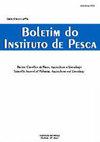Histopathological changes in Lithobates catesbeianus tadpoles used as biomarkers of pesticide poisoning
IF 0.6
4区 农林科学
Q4 FISHERIES
引用次数: 0
Abstract
The use of biological indicators has increased in recent years with the aim of investigating environmental pollution in aquatic environments that are vulnerable to the constant use of pesticides. Some biomarkers can help assess the health status, indicating physical, metabolic, and behavioral changes under acute and sublethal poisoning. The mixture of the active ingredients cyproconazole and picoxystrobin is a widely used fungicide for the control of pests in cotton, rice, coffee, sugarcane, corn, soybean, and wheat. The objective of this study was to verify the occurrence of possible histopathological lesions in the liver and kidneys of bullfrog tadpoles (Lithobates catesbeianus) caused by a fungicide commercial formula composed of picoxystrobin and cyproconazole. The animals were subjected to different concentrations of the fungicide to determine the median lethal concentration (LC50-96h = 0.05 mg L-1), that is, the lethal dose for 50% of the animals in 96 h. After determining the value of LC50-96h, the animals were subjected to three sublethal concentrations (LC50-96h/2, LC50-96h/10, and LC50-96h/100). Through histological biomarkers, it was verified that this fungicide changed the morphology of the animals' kidney and liver tissues in a chronic way, impairing the functioning of organs that are essential for their survival and metamorphosis, which can result in an imbalance in the biodiversity of aquatic ecosystems.作为农药中毒生物标志物的斑蛙蝌蚪的组织病理学变化
近年来,生物指标的使用有所增加,目的是调查易受持续使用农药影响的水生环境的环境污染。一些生物标志物可以帮助评估健康状况,表明急性和亚致死中毒下的身体、代谢和行为变化。环丙康唑与吡嘧菌酯混合而成的有效成分是一种广泛应用于棉花、水稻、咖啡、甘蔗、玉米、大豆、小麦等害虫防治的杀菌剂。本研究的目的是验证一种由吡嘧菌酯和环丙康唑组成的杀菌剂在牛蛙蝌蚪(Lithobates catesbeianus)肝脏和肾脏可能发生的组织病理学病变。测定不同浓度杀菌剂对动物的中位致死浓度(LC50-96h = 0.05 mg L-1),即96h内50%动物的致死剂量。测定LC50-96h值后,分别对动物进行3种亚致死浓度(LC50-96h/2、LC50-96h/10、LC50-96h/100)处理。通过组织学生物标志物证实,该杀菌剂慢性改变了动物肾脏和肝脏组织的形态,损害了其生存和变态所必需的器官的功能,从而导致水生生态系统生物多样性的失衡。
本文章由计算机程序翻译,如有差异,请以英文原文为准。
求助全文
约1分钟内获得全文
求助全文
来源期刊

Boletim do Instituto de Pesca
FISHERIES-ZOOLOGY
CiteScore
0.80
自引率
0.00%
发文量
24
审稿时长
>12 weeks
期刊介绍:
To publish original articles of research and short communications in the following áreas: Fisheries, Aquaculture, Zootechnology, Limnology, Oceanography, Biology and Pathology of aquatic organisms. The publication depends on the approval of the Editorial Board, based on the peer review.
 求助内容:
求助内容: 应助结果提醒方式:
应助结果提醒方式:


